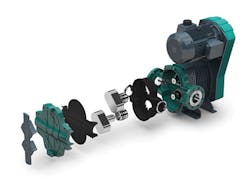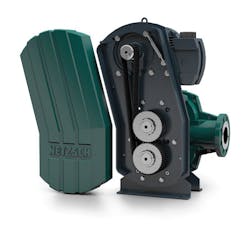Reducing Total Cost of Ownership with New Rotary Lobe Pump Design
New rotary lobe pump designs are challenging conventional wisdom, going a long way toward resolving typical customer pain points. One example is the NETZSCH TORNADO T2 rotary lobe pump, redesigned to improve performance, guarantee high reliability, durability, and ease of maintenance, as well as reduce total cost of ownership (TCO).
Traditional rotary lobe pumps use rubber-covered lobes that rotate inside a metal housing, often with bolted-in metal wear liners. Recently, NETZSCH engineers decided to reverse the construction, using steel lobes and rubber housing. They used this concept during design of the new TORNADO T2 rotary lobe pump. During the entire pumping cycle, only elastomer and metal component surfaces interface within the pump - eliminating the excess wear and heat generated from elastomer-to-elastomer contact that sometimes damages traditional rotary lobe pumps.
By using dissimilar materials for the static and dynamic pump head components, the elastomeric surfaces are subjected to lower dynamic loading, resulting in less plastic deformation and stress, reducing wear and extending operational life. The new design does not require O-rings or gaskets, resulting in a durable and robust construction, along with simplicity and ease of maintenance.
Another design change was the use of a single, synchronous toothed timing belt to drive and synchronize the pump shafts, rather than a set of timing gears. The tooth belt drive system eliminates the maintenance-intensive and costly gearbox and the oil required to run it, lowering operational costs and demonstrating environmental awareness and sustainability. It also improves maintenance through more accurate synchronization, generates less heat, and is much quieter. This belt drive can also be used in conjunction with a frequency converter to achieve a specific flow rate or range of flow rates.
Another design innovation minimizes pulsation while still using durable and simple bi-lobe rotors that are better for solids handling. The unique pulsation reduction system uses channels molded into the liner’s rubber walls to release the lobe energy and dampen pulsation. This is the equivalent of using a multi-lobe rotor, meeting customer demands for shear-sensitive product conveyance and no pulsation downstream.
The pump housing design includes integrally cast round flanges, which provides full flange-to-flange access when servicing the pump. Maintenance personnel have more room to access pump internals without the need to disassemble piping. A unique seal design greatly reduces the chance of leaks and catastrophic pump failure.
This full “service-in-place” design enables easy access to the mechanical seals, rotors, and liners. Using a tool designed especially for the TORNADO T2 to radially and axially align the lobes, personnel can set pump timing in less time than it takes to look for the tools to work on a conventional lobe pump with a timing gearbox.
The new technology challenges a few traditional conventions, and in doing so, has successfully reduced TCO, a critical concern to all pump owners and operators.
NETZSCH is a mid-sized, family-owned German manufacturer of machinery and instrumentation with worldwide production, sales, and service branches. To learn more, visit www.netzsch.com.
More WaterWorld Current Issue Articles
More WaterWorld Archives Issue Articles


